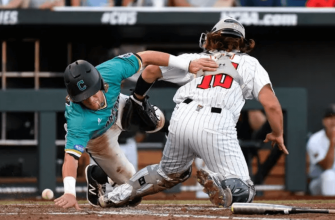If you enjoy baseball, you’ve probably heard the phrase “slugging percentage.” But what is it exactly? We will examine the idea of slugging % in baseball, how it is determined, and why it is such an important statistic in the game in this extensive tutorial.
What is Slugging Percentage in Baseball?
In the simplest terms, slugging percentage is a measure of a baseball player’s batting productivity. It’s a statistic that considers both whether a player receives a hit and the kind of that hit. A single, double, triple, and home run all have different values in the calculation of slugging percentage, reflecting their varying impacts on the game.
How to Calculate Slugging Percentage?
Slugging % computation is actually pretty simple, despite initially appearing to be complicated. By dividing the total number of bases a player has amassed through hits by the total number of at-bats they have had, it is determined. The equation is (1B + 2Bx2 + 3Bx3 + HRx4)/AB, where AB stands for at-bats and 1B, 2B, 3B, and HR are singles, doubles, triples, and home runs, respectively.
Example Calculation
Let’s illustrate this with an example. Suppose a player has had 100 at-bats, with 20 singles, 15 doubles, 5 triples, and 10 home runs.
The slugging percentage would be calculated as follows: (20 + 15×2 + 5×3 + 10×4)/100 = 1.00.
This means that, on average, the player earns one base per at-bat, which is quite impressive!
What Constitutes a Good Slugging Percentage?

So, what makes for a good slugging percentage?
A slugging percentage of 400 or less is typically regarded as average, while a slugging percentage of 500 or more is great. However, these benchmarks can vary depending on the context, such as the league and era in which the player is playing.
The Historical Context of Slugging Percentage
The concept of slugging percentage has a long history in baseball. It was first introduced in 1867 by Henry Chadwick, a sportswriter and baseball statistician who is often credited with developing the box score and other key baseball statistics.
Who Invented Slugging Percentage?
While Chadwick introduced the concept, the modern version of slugging percentage, which measures total bases per at-bat, was adopted by the National League in 1923 and the American League in 1946.
Career Slugging Percentage Leaders in Baseball
When it comes to career slugging percentage leaders, some names stand out. Babe Ruth tops the list with a career slugging percentage of .6897, followed by Ted Williams (.6338), Lou Gehrig (.6324), Jimmie Foxx (.6093), and Barry Bonds (.6069).
Top 5 Players with Highest Career Slugging Percentage
| Rank | Player | Career Slugging Percentage |
|---|---|---|
| 1 | Babe Ruth | .6897 |
| 2 | Ted Williams | .6338 |
| 3 | Lou Gehrig | .6324 |
| 4 | Jimmie Foxx | .6093 |
| 5 | Barry Bonds | .6069 |
The Relationship Between Slugging Percentage and Other Baseball Metrics
Slugging percentage is just one of many statistics used to evaluate a player’s offensive performance. It frequently goes hand in hand with other statistics like batting average and on-base percentage. The capacity to get hits is measured by batting average, which does not distinguish between different kinds of hits.
On-base %, on the other hand, accounts for all possible methods a player can get to base, including walks and getting hit by a pitch.
When combined, these three statistics form another important metric: OPS, or On-Base Plus Slugging.
OPS provides a more comprehensive measure of a player’s offensive performance, taking into account both their ability to get on base and their hitting power.
The Influence of Slugging Percentage on Winning Games
Slugging percentage can have a significant impact on winning games. Teams with players who have high slugging percentages often score more runs, as these players are more likely to hit doubles, triples, and home runs, which can drive in multiple runs at once. Therefore, a team’s collective slugging percentage can be a good indicator of its offensive strength and potential for success.
Slugging Percentage in Player Evaluation and Strategy
In the world of baseball, slugging percentage is a key tool for player evaluation and strategic decision-making. Scouts look at a player’s slugging percentage to assess their hitting power, while managers might use it to decide batting order. For instance, players with high slugging percentages are often placed in the middle of the batting order to maximize their chances of driving in runs.
Historical Trends in Slugging Percentage

Over the years, slugging percentages have seen some interesting trends. For instance, the “live-ball era” that began in the 1920s saw a significant increase in slugging percentages, thanks in part to players like Babe Ruth who were known for their power hitting. More recently, the “steroid era” of the late 1990s and early 2000s also saw a surge in slugging percentages.
Limitations of Slugging Percentage
While slugging percentage is a valuable statistic, it’s not without its limitations. For one, it doesn’t account for walks, which are an important part of a player’s offensive contribution. It also doesn’t consider a player’s speed on the bases. A player who hits a lot of singles but is fast enough to steal second base can be just as valuable as a player who hits a lot of doubles.
Notable Achievements Related to Slugging Percentage
In the history of Major League Baseball, there have been some remarkable achievements related to slugging percentage. For instance, Barry Bonds holds the record for the highest single-season slugging percentage with a staggering .863 in 2001. Meanwhile, Ted Williams holds the record for the highest slugging percentage in a rookie season with .609 in 1939.
Frequently Asked Questions
What is a good slugging percentage in baseball?
Generally, a slugging percentage of .400 is considered average, while a slugging percentage of .500 or higher is excellent. However, these benchmarks can vary depending on the context, such as the league and era in which the player is playing.
Is 1.000 a good slugging percentage?
Yes, a slugging percentage of 1.000 is exceptional. This means that, on average, the player earns one base per at-bat, which is quite impressive. However, maintaining a slugging percentage of 1.000 over a long period is extremely difficult and rare.
What is the MLB average slugging percentage?
The average slugging percentage in Major League Baseball typically hovers around .400 to .450. However, this can vary from year to year and between the American and National Leagues.
Is slugging .500 good?
Yes, a slugging percentage of .500 is considered excellent. This means that the player, on average, earns half a base per at-bat, indicating a high level of hitting power.
Conclusion
Slugging percentage is a crucial statistic in baseball that provides a measure of a player’s hitting power. Whether you’re a player looking to improve your game, a coach devising strategies, or a fan trying to understand the game better, understanding slugging percentage can give you valuable insights into the game of baseball.








